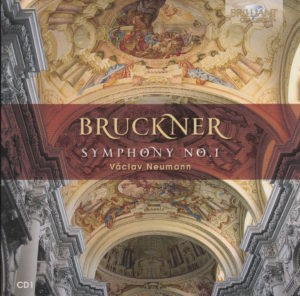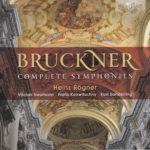 This morning’s conductor of Anton Bruckner’s Symphony No. 1 in C Minor (WAB 101) is Czech-born Vaclav Neumann (1920-1995), another person about whom I knew nothing and had never even heard of until I started this project.
This morning’s conductor of Anton Bruckner’s Symphony No. 1 in C Minor (WAB 101) is Czech-born Vaclav Neumann (1920-1995), another person about whom I knew nothing and had never even heard of until I started this project.
From his entry on Wikipedia:
Václav Neumann (29 September 1920 – 2 September 1995) was a Czech conductor, violinist and viola player.
Neumann was born in Prague, where he studied at the Prague Conservatory with Josef Micka (violin), and Pavel Dědeček and Metod Doležil (conducting). He co-founded the Smetana Quartet, playing 1st violin and then viola, before conducting in Karlovy Vary and Brno. In 1956, he began to conduct at the Komische Oper in Berlin, leaving in 1964 to become conductor of the Leipzig Gewandhaus Orchestra. He stayed there until 1968, when he became principal conductor of the Czech Philharmonic, a post he held until 1990.
In doing research on Vaclav Newmann, I discovered a brief (5-minute) video on YouTube called “Václav Neumann – Life of a Conductor.” Take a look:
Also, here is a very fine bio of him on the very fine Naxos label.
I thought the conductor for this morning’s symphony was going to be Heinz Rogner. But who can blame me? The largest name on the cover of the box set is Heinz Rogner. (See below, right.) So, naturally, I positioned this CD after yesterday’s Paternostro performance (R comes after P, you see). However, now it appears this box set – released by the extraordinary Brilliant Classics label – only listed Heinz Rogner’s name larger than the others, giving the impression that it was a Heinz Rogner-conducted series of Bruckner symphonies. Boy, do I have egg on my face.
No worries, mate. (Can you tell I’ve been watching Crocodile Dundee?)
 For the same reason why I positioned the Bruckner Collection box set under “C” in the listening order – even though the set contains recordings from various conductors – I can leave this one right here, regardless who conducts. The box set states its main conductor is Heinz Rogner. So the set stays in the “R” section.
For the same reason why I positioned the Bruckner Collection box set under “C” in the listening order – even though the set contains recordings from various conductors – I can leave this one right here, regardless who conducts. The box set states its main conductor is Heinz Rogner. So the set stays in the “R” section.
Brilliant Classics is my favorite label for Classical music. Most of what I have – all the box sets, anyway – are from Brilliant Classics. Brilliant releases very high-quality music at the most reasonable prices I’ve ever seen. In short, the value of music from Brilliant Classics is unbeatable.
This box is no exception. Bruckner’s First Symphony is extremely well done – despite the fact that the recording is 51 years old. I’m not kidding. This was recorded in December of 1965. Newmann was 47. Aside from a bit of tape hiss, it sounds as warm and alive as though it were recorded last week.
But I’m getting ahead of myself.
First, the objective aspects:
Bruckner wrote his symphonies in four parts. The breakdown of this one (Linz version), from this particular conductor (Neumann) and this particular orchestra (Gewandhausorchester Leipzig, or Leipzig Gewandhaus Orchestra), is as follows:
Allegro…………..13:53
Adagio……………12:54
Scherzo……………8:59
Finale……………..15:34
I’m only going to compare this performance to one from one of my favorite conductors so far: Jochum.
The breakdown from the Jochum interpretation (which uses the Linz version) that I listened to on 9 October 2016 (orchestral performance by Staatskapelle Dresden) was:
Allegro…………..12:29
Adagio……………12:38
Scherzo……………9:02
Finale……………..12:57
This indicates the Neumann interpretation of Bruckner’s Symphony No. 1 in C Minor is about four minutes longer than the one conducted by Eugen Jochum. That’s not really a big deal. Hardly noticeable. The extra minutes come from a slightly lengthened Allegro (Movement I), and a longer Finale (Movement IV). But Neumann’s Scherzo (Movement III) is brisker by three seconds.
The booklet is about 15 pages of information (written by Dirk Stove) about each of the Bruckner symphonies in the box. Regarding Bruckner’s First Symphony, the liner notes read, in part,
Symphony No. 1: The “Saucy Shrew” in untamed form
Musicians have been known to remark ironically that Anton Bruckner did not compose nine symphonies, but composed the same one nine times. Like all aphorisms, it contains a grain of truth. Bruckner’s symphonies resemble each other more than those of any other notable symphonist since Beethoven. Nonetheless, one of Bruckner’s symphonies is entirely different from the others: the first…Even the first bars speak their own language…
Indeed. And the language they speak is, well, I’m getting ahead of myself again.
The booklet is excellent, with one glaring oversight: It offers no information about the conductor, the venue, the orchestra – essentially, no one playing the music Bruckner wrote. Weird, huh?
Okay. Now, here are the subjective aspects:
My Rating:
Recording quality: 5 (Brilliant Classics lives up to its name)
Overall musicianship: 5
CD liner notes: 3 (box set contains liner notes, but they don’t say anything about the conductor or the orchestra!)
How does this make me feel: 5
This is an engaging, beautiful piece of music, well performed. And the magic is back in the final minute and a half of the Adagio (Movement II). Yea!
What is it is about specific recordings that appeals to me? Is is the conductor? The orchestra? The ambient sound of the venue? How it was recorded? When it was recorded?
I don’t know. Maybe I’ll never know. Or maybe I’ll be able to deduce it once I’ve heard all of these recordings and notice commonalities. That’s part of the fun of doing this – to find patterns and preferences.
All I know is Neumann’s interpretation – on this record label, using this orchestra – appeals to me a great deal. The music is big, bold, expressive, engaging, and accessible. I listened to this CD 4-5 times through. And I still find passages in it that I didn’t hear before.
Vaclav Neumann’s turn at the rostrum is highly recommended, is this recording from the Brilliant Classics label. I’m looking forward to hearing the other symphonies in this box.

Vaclav Neumann was a very great conductor. He was the greatest of all conductors on Mahler. (Only Swarowsky was close competition doing Mahler.)
Neumann was also by far the greatest Shostakovich conductor, but recorded only one work of his, the 7th Symphony, which was Shostakovich’s masterpiece. That performance is a treasure, and dwarfs all others of that work.
On everything else, Neumann was at least very good, and this is because he wasn’t only unsurpassed at communicating to orchestras the emotions that he wanted them to project in the performance, but he was totally selfless in his devotion to and love of the works that he performed.
I sometimes disagree with his vision of what the composer meant or wanted (for example, his Gershwin projected Gershwin’s central European roots, not Gershwin’s love of American culture), but even then I come to love his performance after around a dozen hearings of his performance of it. His penetration was so deep, and his authenticity and unconcern with showmanship — I really can’t think of a greater conductor overall, unless it’s Swarowsky, who was much like Neumann, and who was the ideal Brahms conductor even more than Neumann was the ideal Mahler conductor. (Both Swarowsky and Neumann and also Cluytens were supreme on Beethoven.)
And who was the ideal Bruckner conductor? I’d say it was Heinz Bongartz, who regrettably had only one Bruckner performance published, the Sixth Symphony. Second-best on Bruckner were Karajan (though not the very late V.Ph. Karajan) and Leitner. Third-best on Bruckner, maybe Neumann.
Thanks for writing, Eric. I appreciate it.
Also, I appreciate the information you providing regarding the best conductors for Bruckner.
I love Bruckner. So I’ll probably explore the conductors you named of which I was unaware.
Bill